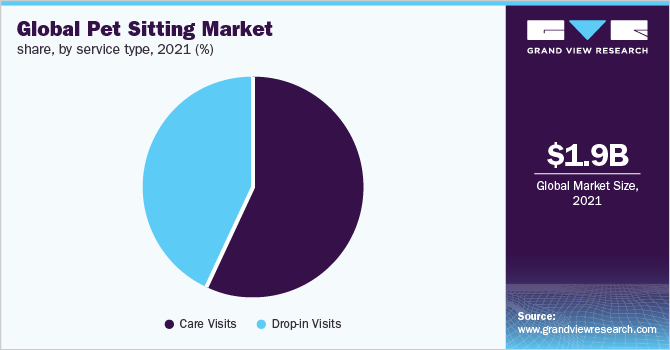The pet care industry has been growing rapidly, with the pet sitting and dog walking segment reaching $1.94 billion in 2021 according to Grand View Research. The global pet sitting service market is estimated to grow at a compound annual growth rate (CAGR) of 11.52% between 2022 and 2030.
As more pet owners need care for their furry friends while they are at work or traveling, the demand for qualified and trustworthy pet sitters has increased. With the pet sitting business market poised to reach $5.14 billion by 2030, now is a great time to get involved.

In this guide, we’ll cover how to start a dog sitting business. Topics include market research, competitive analysis, registering an EIN, applying for business insurance, and more. Here’s everything you need to know about starting your own pet sitting business.
1. Conduct Dog Sitting Market Research
Market research is an important part of starting a dog sitting and dog walking business. It offers insight into market saturation, types of pet sitting business insurance, popular pet sitting services, and more. There are two types of market research for local pet stores and sitting businesses, primary and secondary.
Primary research is research you do yourself. This includes polling pet owners or visiting other pet sitter businesses or pet stores in person.
Secondary research is research conducted by a third party. It might include gathering online market statistics or checking government websites.

Some things to look for during market research include:
- Key market successes: Providing in-home dog sitting and daily walks allows you to offer a more personalized, less stressful experience for pets compared to boarding kennels.
- Target customers: Urban pet owners who live in apartments or condos without yards for their dogs. Suburban professionals with frequent business trips are also a key demographic.
- Competition: Sites like Rover connect pet sitters and dog owners.
As demand continues growing across the country, opportunities abound for dedicated pet care entrepreneurs to build successful dog-sitting ventures.
2. Analyze the Competition
When starting a successful pet sitting business, it’s crucial to assess your local competition. Let’s look at some of the ways to observe dog walking business competitors.

- Search online: Search sites like Rover and Wag Walking to assess independent sitters. Evaluate profiles, reviews, prices, and service areas.
- Visit competing pet sitter businesses: Drive around to get a sense of physical locations. Note commercial kennels as well as home-based sitters advertising services.
- Check social media: Monitoring social media presence also provides useful intel. Assess followers, engagement, and reviews on Facebook and Instagram. This can clue you into larger competitors to watch.
- Ask locals: Partner with clients to hear first-hand about previous sitters. Keep an eye out for new competitors entering the market.
Analyzing the competition from every angle provides valuable insights. Adjust your focus areas based on competitors’ strengths and weaknesses.
3. Costs to Start a Dog Sitting Business
When starting a dog-sitting company, there are various start-up and ongoing costs to prepare your business.
Start-up Costs
Licensing, insurance, training, supplies, and initial marketing will be your primary upfront costs. Let’s break these down further.
- Licensing & Permits – $50-$500 depending on location and business offerings.
- Insurance – $500-$2,000 for general liability, commercial auto, and commercial real estate insurance.
- Pet Sitting Training – $100-$500 private and shared classes.
- Supplies – $300-$1,000 for equipment like leashes, waste bags, pet first aid kits, and grooming supplies.
- Marketing – $500-$1,500 Business cards, flyers, website, and sticking for your car.
Plan to spend between $1,950 and $5,500. With careful planning, you can launch a dog-sitting operation for under $2,000.
Ongoing Costs
Ongoing costs are expenses you encounter throughout the life of your business. Here’s a look at some common ongoing costs.
- Marketing – $100-$300 to invest in SEO, Google/Facebook ads, print/radio ads, and other outreach.
- Insurance – $30-$100 for your liability and other business coverage plans.
- Accounting Software – $10-$50 for programs like QuickBooks to help track your finances and expenses.
- Office Supplies – $20-$100 like restocking waste bags, replacing worn leashes, replenishing grooming supplies, and other operating materials.
- Phone/Internet – $50-$100 monthly depending on suppliers.
- Transportation – $200-$500 for gas, maintenance, and depreciation costs from extensive driving to client homes.
- License Renewal – $50-$150 Licenses generally need to be renewed annually for a small fee.
- Bonding/Insurance Renewal – $500-$2,000 Your annual liability insurance premiums. Shop policies for the best rate.
- Continuing Education – $100-$300 Invest in annual training to expand your pet care knowledge.
- Marketing Boost – $500-$1,500 Seasonal boosts during peak times of the year to promote your services.
With some fixed costs and some variable expenses based on your client volume, plan for approximately $2,000 to $7,000 in ongoing costs.
4. Form a Legal Business Entity
When starting a dog-sitting company, choosing the right legal structure is key. The four main options each have advantages and disadvantages to weigh.
Sole Proprietorship
Sole Proprietorship This is the simplest structure where you own the business as an individual. The major pro is it’s easy and inexpensive to set up. You can get started quickly by registering a DBA name. However, you’re personally liable for all debts and legal claims, which pose a substantial risk for a dog-sitting business where injuries could occur.
Partnership
Partnership Forming a partnership spreads liability risks across multiple owners and allows you to combine resources. But personal assets aren’t fully protected. Disagreements between partners can also dissolve the business if you don’t establish clear roles. Profit splitting would need to be negotiated carefully.
Limited Liability Company (LLC)
Limited Liability Company (LLC) For dog sitting, an LLC provides the best mix of benefits. It protects your assets from any business lawsuits or claims related to pet injuries or damages. Tax-wise, profits pass through to members avoiding corporate taxation. You benefit from the credibility of an official registered company. LLCs also allow you to take on investors or co-owners seamlessly in the future.
Corporation
Corporation Establishing a corporation shields your assets much like an LLC. However, corporations come with more administrative work like issuing stock certificates and holding board meetings. You also miss out on pass-through taxation so profits are taxed at both corporate and personal levels.
5. Register Your Business For Taxes
One key legal task when starting a dog-sitting company is obtaining an Employer Identification Number, or EIN. This unique identifier acts like a social security number for your business for tax and banking purposes.
An EIN is required if you have any employees, operate as a corporation or partnership, or need to open a business bank account. For dog sitting, having an EIN makes your business entity official in the eyes of the IRS and banks.
The good news is applying for an EIN is quick and free through the IRS website. You simply provide basic information about your LLC or company and the IRS instantly issues your EIN.
To apply, have details like your LLC formation date, registered business name, address, and owners’ social security numbers ready. The online application takes less than 15 minutes to complete and get your EIN.
You will also need to check your individual state’s requirements for sales tax registration. Most states require collecting and remitting sales tax if your pet-sitting revenue exceeds a set threshold. Apply for a seller’s permit with your state revenue or taxation department.
For example, in California, you must register with the California Department of Tax and Fee Administration for a seller’s permit if you earn over $500,000 in gross receipts annually. Check your state’s registration laws.
Obtaining an EIN and sales tax permit legitimizes your pet care business. Be sure to handle these registrations promptly after forming your LLC. Confirming you are compliant with IRS and state rules from the outset keeps your dog-sitting venture on solid legal footing as you are serving clients.
6. Setup Your Accounting
As a pet-sitting entrepreneur, implementing organized accounting practices from the start is crucial. With multiple clients and recurring service bills, keeping clear records saves headaches at tax time.
Open a Business Bank Account and Credit Card
Begin by establishing dedicated business banking and credit accounts separate from personal finances. This delineation helps avoid red flags with the IRS and simplifies expense tracking. Open a free small business checking account and apply for a credit card like Capital One Spark Cash with 2% cashback on every purchase.
Get Accounting Software
Invest in software like QuickBooks to automate tracking income and expenses. Connect bank/credit accounts to sync transactions. Generate invoices for clients and let the software reconcile accounts payable/receivable. This streamlines bookkeeping and provides IRS-ready reporting.
Hire an Accountant
Consider hiring an accountant, especially for year-end tax preparation. Expect fees around $200-$500 for individual filing. Accountants can audit your records to maximize write-offs like mileage deductions from driving to appointments. If you get audited, having a professional who prepared your taxes adds legitimacy.
7. Obtain Licenses and Permits
When preparing to open a dog-sitting company, one of the most important legal steps is obtaining any required state and local licenses or permits. Check with the U.S. Small Business Administration to find federal license requirements. The SBA search tool shows local permit requirements.
In most cases, you will need a general business license to provide pet care services in your city or county. Many states also institute additional pet care facility permits or licenses. California mandates a Pet Daycare Facility Permit from the Department of Consumer Affairs for any business boarding three or more dogs overnight. This involves submitting floor plans, care protocols, and permitting fees.
Individual cities often have their own pet shop permit rules. Chicago requires a $300 Animal Care Facility Permit for boarding two or more pets. Renewals and premises inspections apply. Dallas mandates a $200 permit if keeping six or more pets on-site. Stay aware of all guidelines.
Many states require specific Pet Handler Permits or Certifications if caring for animals. Florida institutes a License for Animal Care Technicians for those handling dogs. Pennsylvania’s K9 Handler Permit applies to those assisting law enforcement dogs. Stay educated on the intricacies of your region.
8. Get Business Insurance
Carrying proper business insurance is strongly advised when operating a dog-sitting venture. Policies protect your company in the event of unfortunate incidents. Without coverage, a single accident could devastate your finances or force you to close entirely.
Imagine a dog escapes from your care and causes a car accident. The claimant’s damages and legal fees could drain your savings without liability insurance. Or envision an aggressive dog biting a sitter requiring hospitalization. Medical bills may stick you with massive debt sans workers’ compensation. If a pampered show dog under your watch gets loose and injured, the owner may sue for negligence without adequate coverage.
Safeguard against these worst-case scenarios by obtaining policies like:
- General liability – Covers third-party property damage/bodily injury claims
- Professional liability – Protects against alleged negligence or errors
- Pet insurance – Reimburses vet costs if a pet gets sick or injured
- Workers’ compensation – Handles employee injuries
Expect about $300 to $800 annually depending on your needs. Receive quotes from multiple carriers to compare. Apply online or work with a business insurance broker. Have your LLC formation documents, staff count, and projected revenue ready.
9. Create an Office Space
Securing office space can provide legitimacy and convenience for pet-sitting operations. An official home base helps meet with prospective clients, conduct consultations, store supplies, and handle administrative work.

Home Office
A dedicated home office allows you to meet clients by appointment without leaving your residence. Expect costs of $50 to $150 for a desk and basic supplies. Deduct a portion of utility bills for the space. However, some clients may prefer a more professional environment.
Coworking Office
Coworking spaces like WeWork offer convenient shared offices for $150 to $500 monthly. Gain a business address and access to amenities like WiFi, printing, conference rooms, and kitchens. They provide flexibility to upgrade as your company grows. However, costs add up for limited actual usage.
Retail Office
For established operators, leasing a private storefront office space provides the most professional setup for meeting clients. While pricier at $1,000 to $2,500 monthly, the visibility and facilities like boarding kennels and yards may merit the investment.
10. Source Your Equipment
Launching a dog sitting company does not require major upfront investments in expensive equipment. With lean startup costs, you have flexibility in sourcing any necessary materials. Here are some options:
Buy New
For brand-new gear, visit pet supply shops like Pet Supplies Plus. Stock up on essentials like leashes, waste bags, bowls, crates, and first aid kits. Expect to spend $300 to $500 on initial inventory. Large retailers offer convenience but products lack uniqueness.
Buy Used
Quality used equipment can be found via Craigslist, Facebook Marketplace, and eBay. Search for crates, exercise pens, and sturdy leashes. Vintage items like leash hooks or food containers add charm. Thoroughly sanitize anything used. Used deals require more legwork but provide cost savings of around 50%.
Rent
Renting Need large equipment like agility obstacles or playsets temporarily? Event rental companies like partysuppliesdelivered.com offer reasonable short-term rentals. Useful for trials or special engagements. Daily pricing in the $50 to $150 range can be cost-effective long-term.
Lease
Leasing Leasing lets you pay monthly for essentials like transportation and gear. Lease a van to haul multiple dogs. Programs offer discounted pet-sitting marketing materials for $29 per month with no commitment. This preserves capital for other startup costs.
11. Establish Your Brand Assets
Crafting a distinctive brand identity is crucial for standing out in the pet care industry. Invest time upfront in creating professional materials to attract clients.
Get a Business Phone Number
Secure a dedicated business phone line through providers like RingCentral. Choose a local number and customize a professional voicemail greeting. Expect costs of around $30 per month. Having a proper business number establishes legitimacy.
Design a Logo
Design a polished logo that encapsulates your brand vision. Services like Looka make it easy to create icons, monograms, or modern emblems for under $50. Repeating your logo across materials helps recognition.
Print Business Cards
Print quality business cards to hand out to potential clients and vets. Include essential info like your phone, email, website, and social media. Sites like Vistaprint offer affordable packages starting around $10 for 250 cards.
Get a Domain Name
Secure a domain name that matches your brand for a website. Short .com names project professionalism. Sites like Namecheap offer domains for less than $15 annually.
Design a Website
Building a website establishes an online presence where prospective clients find your contact info, services, and pricing. Consider DIY platforms like Wix to launch quickly. Or hire a freelancer from Fiverr for a fully custom responsive site.
12. Join Associations and Groups
Joining relevant local organizations and online communities provides invaluable connections when starting a pet care company. Surround yourself with a support network.
Local Associations
Seek local pet business associations like Pet Sitters International that offer mentorship opportunities with established sitters. Attend new member meetings to ask questions. Expect dues of around $50 to $100 to access resources.
Local Meetups
Sites like Meetup list pet care networking events and workshops to meet fellow sitters and walkers. Search for local groups focused on business education. Expect free or paid entry for around $5 to $20 per meeting.
Facebook Groups
Online communities provide networking as well. Facebook groups like Pet Sitters and Pet Owners Community have over 8,000 members to connect with.
Surrounding yourself with supportive pet pros helps you continually improve services and business operations. Membership fees and event costs pay dividends through invaluable connections and growth opportunities. Tap this community early on.
13. How to Market a Dog Sitting Business
Implementing ongoing marketing is imperative for gaining new pet sitting clients and growing your venture. A multifaceted approach works best for sustained success.

Explore Your Network
Leverage your existing network first. Offer discounts for referrals. Satisfied clients providing word-of-mouth endorsements organically attract neighborhood pet owners based on trust.
Digital Marketing
For digital promotion, utilize:
- Google Ads – Target nearby searchers of phrases like “dog sitters near me”
- Facebook Ads – Hyperlocal ad campaigns focused on pet owner demographics
- YouTube Channel – Post pet care tips, share day-in-the-life videos
- Blogging -Optimize articles for SEO to drive organic traffic
- Social media marketing – Post engaging content showcasing your services
- Reviews – Proactively collect positive testimonials on Google, Facebook, Yelp
Traditional Marketing
Traditional options include:
- Direct mail postcards – Send promotional offers to local homes
- Business partnerships – Offer discounts at vet clinics, pet stores
- Community bulletins – Post fliers at local shops, parks, and walking trails
- Pet-friendly events – Set up a booth at festivals, expos, and fairs
- Radio ads – Boost awareness with local station spots
- Print ads – Take out ads in city guides, apartment magazines
Test different formats and analyze metrics to determine optimal ROI. As your reputation grows, word-of-mouth referrals will accelerate. Maintain reasonable budgets, track outcomes, and refine strategies over time.
14. Focus on the Customer
Providing exceptional customer service is imperative for any pet-sitting company to gain loyal clients and word-of-mouth referrals. When owners trust you with their precious furry family, they expect compassionate care and communication. Here are some ways to connect:
- Respond promptly: Reply to all inquiries, provide thoughtful consultations, and follow up after meetings.
- Be available: Be available by phone/text for any questions that arise during your stay. Send photo updates so owners see their pets happy and well cared for.
- Go above and beyond: Provide handwritten report cards upon return with fun details about playtime and walks.
- Be transparent: If any incidents occur, contact the owner immediately. Be transparent and sympathetic in resolving issues.
Quality care paired with heartfelt service earns glowing referrals. Satisfied clients pass your name along enthusiastically when friends need a sitter. Experiences shape your reputation. This personal recommendation marketing remains invaluable as you grow.
